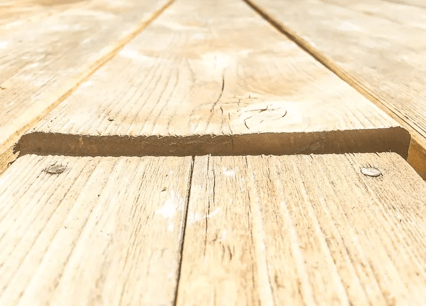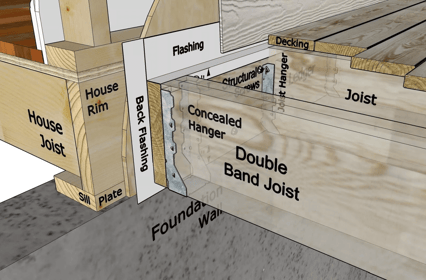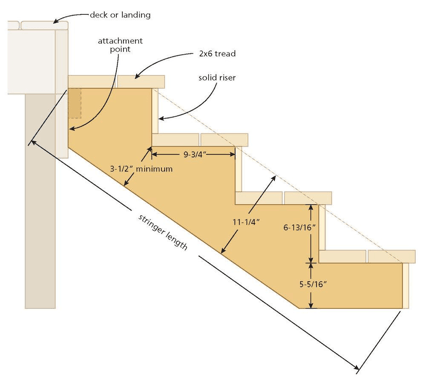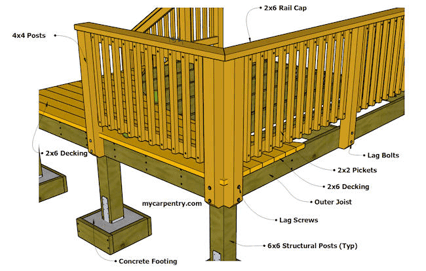NADRA National Deck Safety Month - How to Keep your Deck Safe
March 22nd, 2023
6 min read
As the warmer weather approaches, spending time out on your deck with friends and family is a great way to enjoy the sunshine and fresh air.
To make sure your deck is safe to use during the beautiful summer months, now is the time to find and fix any safety issues.
To help you understand the importance of keeping your deck safe, the North American Deck & Railing Association (NADRA) has designated May as Deck Safety Month®.
As a Mid-Michigan deck designer and builder with over 15 years of experience, we have built over 100 decks of all shapes and sizes. Deck safety is of utmost importance, as the consequences can be dire when a deck is allowed to fall into disrepair.
In this article, you’ll learn about NADRA’s Deck Safety Month® and the importance of deck safety. You’ll also go through a ten-point checklist you can use to look for potential hazards on your deck.
What is Deck Safety Month®?
NADRA’s Deck Safety Campaign creates an opportunity to “Educate. Inspect. Correct.,” ultimately helping to prevent injuries and bringing awareness to the importance of regular deck inspections.
With over 60 million decks in the U.S. (50 million residential and 10 million commercial) it is estimated that over 30 million decks are past their safe life span and need to be repaired or replaced.
Why is Deck Safety Month® important?
According to the United States Consumer Product Safety Commission, (CPSC) between 2016 and 2019 approximately 2,900 people were injured and 2 people killed as a result of deck, porch, and balcony collapses and failures.
Had these outdoor structures been properly inspected and repaired, these tragedies could have been prevented.
To prevent these types of incidents from happening, NADRA provides you with guidelines to check your deck for safety issues.
You may be able to make some of the repairs yourself, or you may wish to hire a professional deck builder to fix them for you. Either way, you’ll want to make sure you follow established regulations to ensure your structure is built durably and safely.
10-point deck safety checklist (signs your deck may need to be repaired or replaced)
NADRA has provided you with the “Check Your Deck® Consumer Checklist” to help you identify potential safety concerns on your deck. Check your deck for:
1. Split or decaying wood
To check for split or decaying wood on your deck, inspect various areas of the deck, such as the ledger board, support posts, joists, and deck boards.
Pay special attention to areas you know remain damp longer than other areas. These spots may be more prone to damage than areas that dry faster.
Split wood

Decaying wood
Split or decay is indicative of wood that is much weaker than when it was new and is a sign that your deck may not be safe. You will want to determine what will need to be repaired or replaced.
2. Damaged flashing
Deck flashing is a material, typically metal or vinyl, that is installed alongside the exterior of your house to prevent water and moisture from leaking inside your home.
Flashing is placed between the ledger board and the exterior of your home at the main point of contact between your home and the deck.
Flashing

Flashing is hard to access without removing siding and deck boards. NADRA recommends an annual inspection to make sure damaged flashing doesn’t lead to a water leak.
A professional inspector can properly access your flashing to determine if repairs are needed.
3. Loose or corroded fasteners
Fasteners include nails, screws, and anchors that hold your deck together.
Over time, as your deck expands, contracts, and withstands the elements, these fasteners will lose some performance capability.
You may notice fasteners becoming loose and sticking out of your deck boards. While also being an eyesore, protruding fasteners present a definite hazard to people walking on your deck.
Corroded fasteners will look rusted which indicates their structural integrity is being compromised.
Either loose or corroded fasteners are a sign that your deck may need repair or replacement.
A professional deck inspector can examine your fasteners to determine if they are damaged enough to warrant the repair or replacement of your deck.
4. Unsafe stairs
Because stairs pose a natural hazard for those who struggle with mobility, you’ll want to make sure they are in good working condition and free of structural damage.
Deck stair diagram

Examine the attachment point between your stairs and the rest of your deck to ensure they’re affixed securely. There shouldn’t be any wiggle or movement.
Take time to make sure stair risers and treads are thoroughly attached to the stair stringer.
Because of the natural hazard stairs pose, you may want to present any potential issue you discover to a professional inspector to see if your stairs require repair.
5. Unstable railings and banisters
Because railings and banisters are installed solely to prevent serious injury, it’s imperative to keep these in good working condition.
Diagram of railings and banisters

Attempt to move railings and banisters for any indication that fasteners are loose. Make sure to check all railings and banisters along the deck, stairs, or patio.
Make sure posts and rail caps are affixed securely because people are likely to grab and hold onto these.
Railings should be maintained in good condition because if they fail structurally, they present a serious safety hazard to someone who needs them for stability.
It is recommended to have a professional conduct a thorough inspection of your railings and banisters to make sure yours are in good condition.
6. Needed cleaning and maintenance
NADRA recommends keeping your deck free of any debris or leaves. These can present a slipping hazard and produce mildew which lessens your deck’s lifespan.
Keeping your deck properly sealed and coated should not only extend the lifespan of your deck but also keep it looking presentable for longer as well. Sealing and coating are recommended as part of routine maintenance for your deck.
If you discover mildew on your wood deck, use warm soapy water and a scrub brush to remove it.
If your deck isn’t constructed with wood, here are a few steps on how to clean and maintain your composite deck.
7. Hazardous grills, fire pits, chimneys, heaters, and candles
Most people have some sort of grill, fire pit, or other heat-producing feature on their deck. While these create a functional and inviting living space they also pose natural safety hazards when placed or used incorrectly.
According to the National Fire Protection Association (NFPA), the leading area of origin for structure fires involving grills is an exterior balcony or open porch, and 44 percent of the property damage from grill fires resulted from fires that started on porches or decks.
It is recommended to place your grill at least three feet on all sides from the walls of your home, and a non-flammable pad underneath heat sources to prevent damage to your deck. Be sure to check spacing recommendations for other heat producing features to ensure their safe use on your deck.
8. Improperly functioning lighting and electrical elements
Installing lights on your deck makes your outdoor space easier to use at night. Lights create an enjoyable atmosphere and also increase your deck’s overall safety.
Check all your lighting fixtures for good working light bulbs and make sure they turn on and off properly.
Additionally, it’s not uncommon for your deck to have exterior electrical outlets. Similar to heat-producing elements, electrical components can pose a fire hazard.
Check your outlets for proper electrical activity and keep them clear of any debris that may block them. If you have any concerns with your electrical components, contact a certified electrician to determine if repairs are needed.
9. Broken outdoor furniture
Furniture can make your outdoor space much more enjoyable to use. Whether you have individual patio chairs, a swing hanging from the ceiling, or built-in benches, you’ll want to make sure each is in good condition and doesn’t pose a hazard to whoever sits on them.
Test each piece of furniture to ensure it’s stable. If you store your furniture outside during the winter, make sure it has not been damaged by snow and ice.
If you notice damage to your furniture, consider replacing it.
10. Breakage or decay in surrounding trees
If you’re in the state of Michigan, you likely have trees around your deck. During hot summer months, they provide shaded comfort from the sun and make your deck more enjoyable.
However, trees can pose a safety hazard if left uninspected. Make certain there are no broken or decaying limbs that might fall from the trees surrounding your deck.
If you notice any decaying limbs or broken branches that could pose danger to those who use your deck, reach out to an arborist to remove those branches safely.
Next steps for keeping your deck safe
To ensure that your deck is safe to use during the summer months, it's essential to identify and address any potential safety issues now.
May, NADRA's Deck Safety Month®, serves as a reminder of the importance of keeping your deck in good condition and safe for use all summer long.
Using NADRA’s ten-point checklist will help to make sure your deck is safe for you and your family to use as you gather this summer.
Safety is a top priority at Custom Built. Building beautiful decks and outdoor living spaces for Mid-Michigan homeowners certainly includes addressing all possible safety concerns in the process.
We are proud to promote NADRA’s upcoming Deck Safety Month® this May to educate, inspect, and correct problems with your deck to keep you and your family safe.
If you have found potential issues with your deck during your initial inspection, reach out to our team of expert deck builders. We’d be happy to come out and professionally check if your deck needs to be repaired or replaced.
To learn more about decks or outdoor living spaces, read the following articles:
Michael brings over 2 decades of building and remodeling experience to his position as the Owner and Visionary of Custom Built. Michael’s passion to make an impact on the home building industry has led him to serve for over ten years at the local and state Home Builders Association, culminating as President of the HBA of Michigan in 2020.

